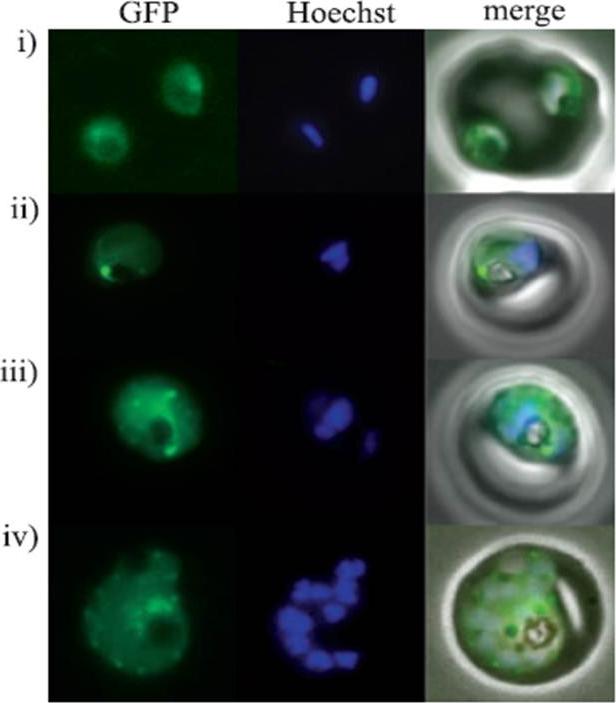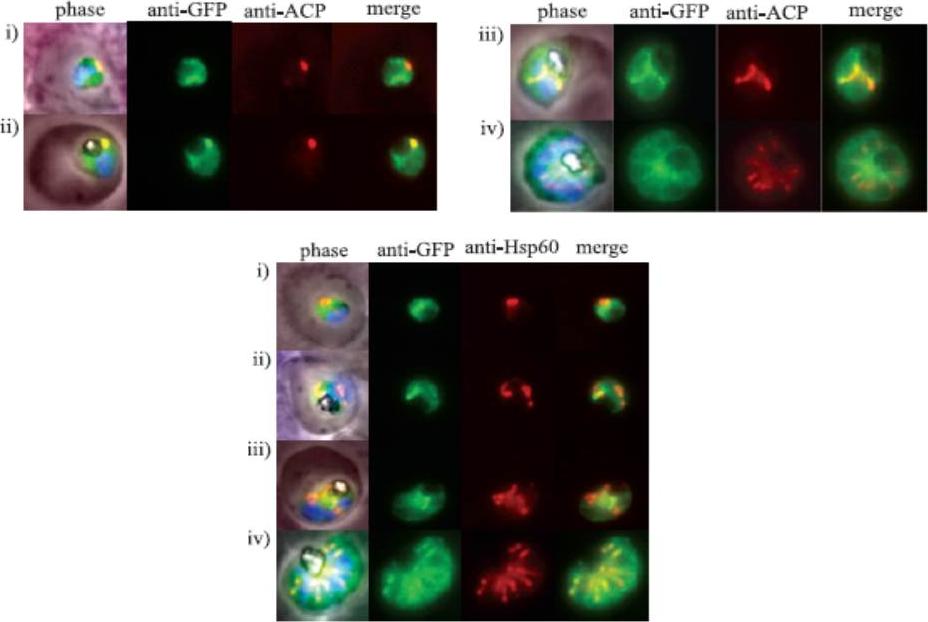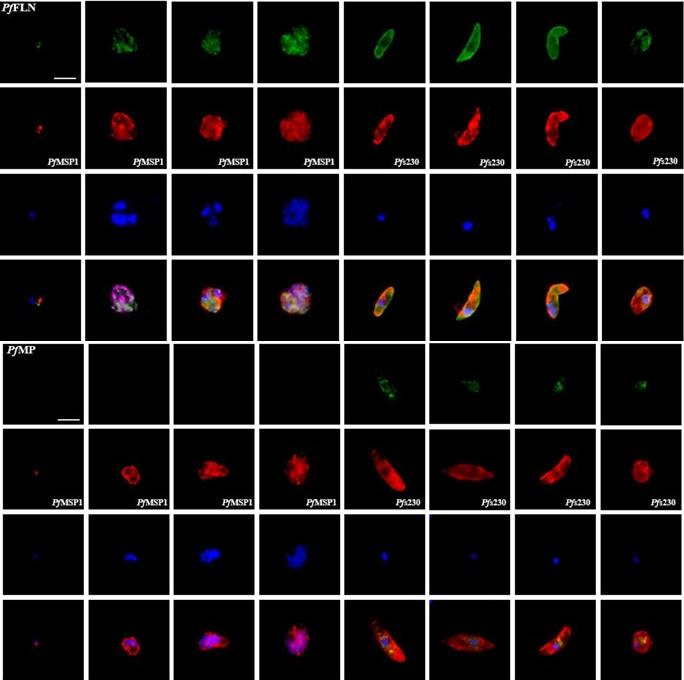PVX_115000 falcilysin, putative
Disruptability [+]
| Species | Disruptability | Reference | Submitter | |
|---|---|---|---|---|
| P. berghei ANKA |
Refractory |
RMgm-804 | Imported from RMgmDB | |
| P. berghei ANKA |
Refractory |
PlasmoGEM (Barseq) | PlasmoGEM | |
| P. falciparum 3D7 |
Refractory |
17074076 | Theo Sanderson, Wellcome Trust Sanger Institute | |
| P. falciparum 3D7 |
Refractory |
USF piggyBac screen (Insert. mut.) | USF PiggyBac Screen | |
Mutant phenotypes [+]
None reported yet. Please press the '+' button above to add one.Imaging data (from Malaria Metabolic Pathways)

Clone MP3 parasites were observed live by epifluorescence microscopy. (i) During the ring stage, FLN is distributed diffusely in the cytosol and persists there throughout the entire cycle. (ii) As rings develop into trophozoites, FLN is concentrated into an intense fluorescent focus. (iii) During the schizont stage, the intense focus appears to elongate and divide. (iv) One intense focus per merozoite is observed in segmenters. Subcellular localization indicates association with the apicoplast. Ponpuak M, Klemba M, Park M, Gluzman IY, Lamppa GK, Goldberg DE. A role for falcilysin in transit peptide degradation in the Plasmodium falciparum apicoplast. Mol Microbiol. 2007 63:314-34
See original on MMP
Upper panels: The intense fluorescent focus of FLN-GFP appears to partially overlap with that of the apicoplast. Clone MP3 parasites were fixed with 4% paraformaldehyde/0.0075% glutaraldehyde and stained with rabbit anti-ACP antibody, a marker for the apicoplast lumen (red) and goat anti-GFP antibody (green). Cells were observed by epifluorescence microscopy. (i–iv) Representative images of cells at ring, trophozoite, schizont and segmenter stages respectively. LOwer panel: FLN–mitochondrion association. Clone MP3 was examined by IFA and epifluorescence microscopy using rabbit anti-Hsp60 (red) and goat anti-GFP (green) antibodies. (i–iv) Representative images of cells at ring, trophozoite, schizont and segmenter stages respectively.Ponpuak M, Klemba M, Park M, Gluzman IY, Lamppa GK, Goldberg DE. A role for falcilysin in transit peptide degradation in the Plasmodium falciparum apicoplast. Mol Microbiol. 2007 63:314-34
See original on MMP
Loss of food vacuolar integrity upon fosmidomycin and wortmannin treatment. Shown is the confocal fluorescence microscopic localization of a plasmepsin II-GFP (P2-GFP) construct (left) or live fluorescence imaging of Lysotracker Red-stained malaria parasites (right). Control parasites (A) are compared to parasites treated for 24 h with either fosmidomycin (B), fosmidomycin plus geranylgeraniol (C), or wortmannin (D). Images are representative of at least three independent biological experiments. Visualization of PMIIGFP in FSM- and wortmannin-treated parasites required higher detector gain levels, resulting in increased observed erythrocyte autofluorescence. Lower panel: Apicoplast and parasitophorous vacuolar targeting in fosmidomycin- and wortmannin-treated parasites. Shown is live-cell fluorescence of malaria parasites that express either the leader sequence (ACPL-GFP) (A) or signal sequence (ACPs-GFP) (B) from P. falciparum acyl carrier protein, fused to GFP, which traffic to the apicoplast or parasitophorous vacuole, respectively. Untreated parasites (control) are compared to fosmidomycin (FSM)- and wortmannin (wort)-treated parasites. Images are representative of at least three independent biological experiments.Howe R, Kelly M, Jimah J, Hodge D, Odom AR. Isoprenoid biosynthesis inhibition disrupts Rab5 localization and food vacuolar integrity in Plasmodium falciparum. Eukaryot Cell. 2013 Feb;12(2):215-23.
See original on MMP
Protein expression profile of selected P. falciparum proteases. IFAs using polyclonal mouse antisera directed against 12 of the proteases was used to demonstrate protein expression in the asexual blood stages (R, ring; T, trophozoite; iS, immature schizont; mS, mature schizont) and gametocytes (GC stages III, IV and V) as well as in macrogametes (MaG) at 20 min post-activation (in green). The asexual and the sexual blood sstages were visualized via immunolabelling with polyclonal rabbit antisera against PfMSP1 and Pfs230, respectively (in red). Hoechst 33342 staining was used to highlight the parasite nuclei (in blue). Bar, 5 μm. Results are representative of three to four independent experiments.Weißbach T, Golzmann A, Bennink S, Pradel G, Julius Ngwa C. Transcript and protein expression analysis of proteases in the blood stages of Plasmodium falciparum. Exp Parasitol. 2017 Mar 25. [Epub ahead of print]
See original on MMPMore information
| PlasmoDB | PVX_115000 |
| GeneDB | PVX_115000 |
| Malaria Metabolic Pathways | Localisation images Pathways mapped to |
| Previous ID(s) | Pv115000 |
| Orthologs | PBANKA_1137000 , PCHAS_1136500 , PF3D7_1360800 , PKNH_1110600 , PVP01_1111200 , PY17X_1138400 |
| Google Scholar | Search for all mentions of this gene |